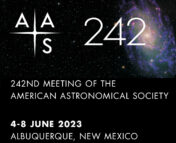This guest post was written by Amanda Zettler, an undergraduate student at the University of Connecticut, for an assignment in the Fall 2019 Foundations of Modern Astrophysics class taught by Professor Cara Battersby. As part of the course, students were tasked with writing an Astrobite-style summary of a topic in astronomy. Amanda studies Physics with a minor in Astrophysics and is a research assistant in an optics lab at the university.

The 2016 movie and book Hidden Figures, brought to light the many contributions of black women to astrophysics. The book Hidden Figures highlights the experiences of three specific black women: Katherine Johnson, Dorothy Vaughan, and Mary Jackson, and the movie brought their stories to an even larger audience. These women led extraordinary lives that were often overshadowed by the accomplishments of their white male colleagues. This representation of black women in astrophysics has been immeasurably important in showing young women and people of color that they can overcome obstacles and succeed in astrophysics. As the movie review from The New Yorker states: “The basic virtue of “Hidden Figures […] and it’s a formidable one, is to proclaim with a clarion vibrancy that, were it not for the devoted, unique, and indispensable efforts of three black women scientists, the United States might not have successfully sent people into space or to the moon and back.”
The women of Hidden Figures each have unique stories and achievements. Katherine Johnson is the focus of the movie and book and holds many titles, such as one of the first three people to integrate West Virginia’s graduate school, and a summa cum laude college graduate at age 18. Her most memorable accomplishment, however, is beyond even these: she got mankind into orbit. She began her journey as a computer in an all-black computing section of a NASA lab, analyzing flight test data for a group of engineers. When these engineers were reassigned to the John Glenn mission, she went with them, launching her career in unimaginable ways.
Despite the odds, Katherine Johnson soon became the one writing her own equations. John Glenn himself said that if she reviewed the equations and numbers for his flight, then he felt safe and was ready to take off. She worked tirelessly, and eventually what started as a job running numbers through a calculator became the pathway to becoming one of the first women at NASA to co-author a research paper. In a time where the world of physics and spaceflight was run by white men, Katherine Johnson let nothing stop her.
Working beside Johnson throughout this journey was Dorothy Vaughn. She was hired as a computer after Roosevelt signed a law banning racial discrimination in public defense. However, black computers were still segregated in a separate wing of NASA’s Langley Laboratory. She was eventually promoted to lead the black female computers, making her NASA’s first black supervisor. She was given access to the whole laboratory, not just the segregated wing, and her intelligence and creativity were finally allowed to flourish. She worked with white computers on projects like writing a handbook about calculating machines. When engineers had difficult tasks, they would request her specifically to work on it. She went on to work in the desegregated Analysis and Computation Division and became an expert in FORTRAN programming. Her grace and resilience in the face of discrimination are as admirable as the hundreds of different coding and computing problems she solved.
One more woman’s story is featured in Hidden Figures: that of Mary Jackson. Jackson fought against so much prejudice in her life and still was so successful and inspiring. As a black woman, she was never taken seriously in her desire to become an engineer. She worked under Dorothy Vaughan as a computer but wanted more. She eventually achieved this dream when she was selected to work in NASA’s Supersonic Pressure Tunnel. To fulfill her duties in the position, she would need to return to school and take engineering classes. She was working full-time, so her only option was night classes offered at a local segregated high school. She took her case to the city court to fight for her ability to participate in an all-white class, and she won. She excelled in her courses and received her engineering qualifications. Jackson became NASA’s first black female engineer and went on to study the behavior of the layer of air around airplanes, writing around a dozen papers on the subject during her fruitful career.
Hidden Figures opened up a much larger conversation about black women in STEM. The stories of these three women give today’s black female astrophysicists a reference point to talk about their own experiences. The movie reached a wide audience, helping to destigmatize black women discussing discrimination in STEM as well as non-black scientists to reflect on how they could reform their practices to be better allies to their black female colleagues. Hidden Figures also tackles the issue of representation. On the off chance that women of color are cast in films, they are often depicted as either aggressive and loud or hypersexualized. Hidden Figures treats Katherine Johnson, Dorothy Vaughan, and Mary Jackson as the well-rounded and brilliant astrophysicists they were. A book and movie like these can help groups that are under-represented in STEM believe in themselves and their abilities no matter how they identify. In telling this story, so many people learned what obstacles these women had to overcome to achieve their dreams and brought to light what further work needs to be done to make STEM more inclusive.




